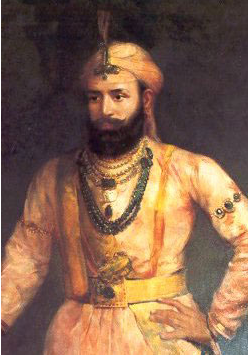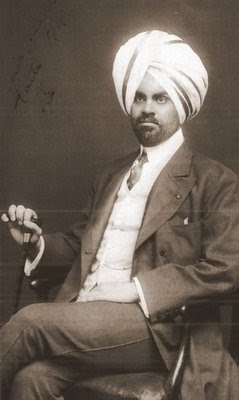Kapurthala State on:
[Wikipedia]
[Google]
[Amazon]
 Kapurthala State, with its capital at Kapurthala, was a former Princely state of
Kapurthala State, with its capital at Kapurthala, was a former Princely state of
'' The Imperial Gazetteer of India'', 1909, v. 14, p. 408. In 1930, Kapurthala became part of the
 * Fateh Singh Ahluwalia (10 July 1801 – 20 October 1837) (b. 1784 – d. 1837)
*
* Fateh Singh Ahluwalia (10 July 1801 – 20 October 1837) (b. 1784 – d. 1837)
*
 * Jagatjit Singh (3 September 1877 – 12 December 1911) (b. 1872 – d. 1949)
* Jagatjit Singh (3 September 1877 – 12 December 1911) (b. 1872 – d. 1949)
Kapurthala
www.sikh-heritage.co.uk {{coord, 31, 23, N, 75, 23, E, region:IN_type:landmark_source:kolossus-svwiki, display=title 1772 establishments in India 1947 disestablishments in India
 Kapurthala State, with its capital at Kapurthala, was a former Princely state of
Kapurthala State, with its capital at Kapurthala, was a former Princely state of Punjab
Punjab (; Punjabi Language, Punjabi: پنجاب ; ਪੰਜਾਬ ; ; also Romanization, romanised as ''Panjāb'' or ''Panj-Āb'') is a geopolitical, cultural, and historical region in South Asia, specifically in the northern part of the I ...
. Ruled by Ahluwalia
Sikh rulers, spread across . According to the 1901 census the state had a population of 314,341 and contained two towns and 167 villages.Kapurthala state'' The Imperial Gazetteer of India'', 1909, v. 14, p. 408. In 1930, Kapurthala became part of the
Punjab States Agency
The Punjab States Agency was an agency of the Indian Empire. The agency was created in 1921, on the model of the Central India Agency and Rajputana Agency, and dealt with forty princely states in northwest India formerly dealt with by the Prov ...
and acceded to the Union of India in 1947.
In colonial India, Kapurthala State was known for its communal harmony, with its Sikh ruler Jagatjit Singh building the Moorish Mosque for his Muslim subjects. At the time of the Indian independence movement
The Indian independence movement was a series of historic events with the ultimate aim of ending British rule in India. It lasted from 1857 to 1947.
The first nationalistic revolutionary movement for Indian independence emerged from Bengal ...
, the ruler of the Kapurthala State opposed the partition of India and advocated for a united, secular country.
Origins
The ruling dynasty of Kapurthala originated in theAhluwalia misl
Ahluwalia (also transliterated as Ahluvalia) was a misl, that is, a sovereign state in the Sikh confederacy of Punjab region in present-day India and Pakistan. The misl's name is derived from Ahlu, the ancestral village of the misl leaders. The Ah ...
. According to this account, Krishna's descendant Gaj built the fort of Gajni, and lost his life in a battle against a joint Roman
Roman or Romans most often refers to:
* Rome, the capital city of Italy
* Ancient Rome, Roman civilization from 8th century BC to 5th century AD
*Roman people, the people of ancient Rome
*''Epistle to the Romans'', shortened to ''Romans'', a lett ...
- Khorasani army. His son Salibahan established the city of Sialkot, and started the Shak era after defeating the Shaks in 78 CE.
After the Muslim conquest of Punjab, his descendants migrated to the Jaisalmer
Jaisalmer , nicknamed "The Golden city", is a city in the Indian state of Rajasthan, located west of the state capital Jaipur. The town stands on a ridge of yellowish sandstone and is crowned by the ancient Jaisalmer Fort. This fort contains a ...
area, where they came to be known as Bhatti Rajput
Rajput (from Sanskrit ''raja-putra'' 'son of a king') is a large multi-component cluster of castes, kin bodies, and local groups, sharing social status and ideology of genealogical descent originating from the Indian subcontinent. The term Ra ...
tribe. After Alauddin Khalji
Alaud-Dīn Khaljī, also called Alauddin Khilji or Alauddin Ghilji (), born Ali Gurshasp, was an emperor of the Khalji dynasty that ruled the Delhi Sultanate in the Indian subcontinent. Alauddin instituted a number of significant administrativ ...
's conquest of Jaisalmer, some of the Bhatti tribe people's migrated to Tarn Taran district, mingled with Jats. Gradually, they came to be known as Jats, and in the 17th century, they joined Guru Hargobind's army. Ganda Singh of this family raided Lahore
Lahore ( ; pnb, ; ur, ) is the second List of cities in Pakistan by population, most populous city in Pakistan after Karachi and 26th List of largest cities, most populous city in the world, with a population of over 13 million. It is th ...
, whose governor Dilawar Khan persuaded him to join the Lahore army, and assigned him the fief
A fief (; la, feudum) was a central element in medieval contracts based on feudal law. It consisted of a form of property holding or other rights granted by an overlord to a vassal, who held it in fealty or "in fee" in return for a form ...
of Ahlu and some other villages. Ganda Singh's son Sadhu (or Sadho) Singh lived in Ahlu, because of which the family came to be known as Ahluwalia. Sadhu Singh and his four sons married into Kalal families, because of which the family came to be known as Ahluwalia. The descendants of Sadhu Singh son Gopal Singh (who was the grandfather of Jassa Singh) established the royal family of Kapurthala. The British administrator Lepel Griffin (1873) dismissed this account as spurious. The Sikh author Gian Singh, in his ''Twarikh Raj Khalsa'' (1894), wrote that the Ahluwalia family adopted the Kalal caste identity much before Sadhu Singh.
The Ahluwalia misl
Ahluwalia (also transliterated as Ahluvalia) was a misl, that is, a sovereign state in the Sikh confederacy of Punjab region in present-day India and Pakistan. The misl's name is derived from Ahlu, the ancestral village of the misl leaders. The Ah ...
rose to prominence under Jassa Singh Ahluwalia
Sultan-ul-Qaum Sardar Jassa Singh Ahluwalia (3 May 1718 – 23 October 1783) was a Sikh leader during the period of the Sikh Confederacy, being the Supreme Leader of the Dal Khalsa. He was also Misldar of the Ahluwalia Misl. This period ...
, who was the first person to use the name "Ahluwalia". Originally known as Jassa Singh Kalal, he styled himself as Ahluwalia after his ancestral village of Ahlu and belonged to the Kalal community. He is regarded as the founder of the Kapurthala State.
Even after other misls lost their territories to Ranjit Singh's Sikh Empire, the emperor permitted the descendants of Jassa Singh to retain their estates. After the British took over the Sikh territories in 1846, Jassa Singh's descendants became the ruling family of the Kapurthala State.
Religion
Royal dynasty
Sardars
* Jassa Singh (1777 – 20 October 1783) (b. 1718 – d. 1783) * Bagh Singh (20 October 1783 – 10 July 1801) (b. 1747 – d. 1801)Rajas
 * Fateh Singh Ahluwalia (10 July 1801 – 20 October 1837) (b. 1784 – d. 1837)
*
* Fateh Singh Ahluwalia (10 July 1801 – 20 October 1837) (b. 1784 – d. 1837)
* Nihal Singh
Nihal Singh CB (4 May 1863 – 20 July 1901) was the Jat ruler of Dholpur state (1873–1901) in Rajasthan, India. Nihal Singh. Maharaj Rana of Dholpur.
References
*Dr. Ajay Kumar Agnihotri (1985) : "Gohad ke jaton ka Itihas" (Hindi)
*Dr ...
(20 October 1837 – 13 September 1852) (b. 1817 – d. 1852)
* Randhir Singh (13 September 1852 – 12 March 1861) (b. 1831 – d. 1870)
Raja-i Rajgan
* Randhir Singh (12 March 1861 – 2 April 1870) (b. 1831 – d. 1870) *Kharak Singh
Kharak Singh (22 February 1801 – 5 November 1840) was the second Maharaja of the Sikh Empire. He was the eldest son of Maharaja Ranjit Singh, founder of the Sikh Empire and his consort, Maharani Datar Kaur. He succeeded his father on 27 Jun ...
(2 April 1870 – 3 September 1877) (b. 1850 – d. 1877)
 * Jagatjit Singh (3 September 1877 – 12 December 1911) (b. 1872 – d. 1949)
* Jagatjit Singh (3 September 1877 – 12 December 1911) (b. 1872 – d. 1949)
Maharajas
* Jagatjit Singh (12 December 1911 – 15 August 1947) (b. 1872 – d. 1949) *Paramjit Singh *Brigadier
Brigadier is a military rank, the seniority of which depends on the country. In some countries, it is a senior rank above colonel, equivalent to a brigadier general or commodore, typically commanding a brigade of several thousand soldiers. ...
Sukhjit Singh MVC
Crown Princes
* Tikka Raja Shatrujit SinghSee also
*Anita Delgado
Anita Delgado Briones (1890–1962) was a Spanish flamenco dancer and singer from Andalusia who achieved fame for having married the Indian Maharaja of Kapurthala, thus becoming a Rani of Kapurthala.
Biography
She was born on 8 February 1890 in ...
*Political integration of India
After the Indian independence in 1947, the dominion of India was divided into two sets of territories, one under direct British rule, and the other under the suzerainty of the British Crown, with control over their internal affairs remainin ...
References
External links
*Kapurthala
www.sikh-heritage.co.uk {{coord, 31, 23, N, 75, 23, E, region:IN_type:landmark_source:kolossus-svwiki, display=title 1772 establishments in India 1947 disestablishments in India